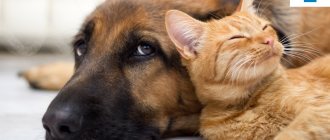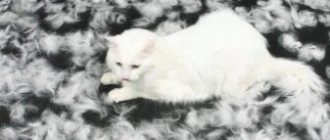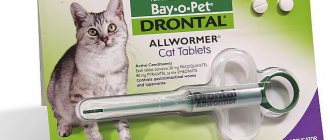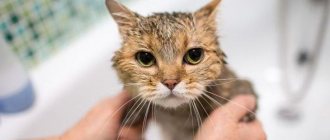The ten most dangerous poisons for cats
Poison No. 1. Medicines for people. Animals are much more sensitive to many common prescription and over-the-counter medications that may be in your home.
Medicines that often poison cats include:
- Non-steroidal anti-inflammatory drugs such as ibuprofen or naproxen. This is the most common cause of animal poisoning. These pain medications can cause ulcers in the stomach and intestines and damage the kidneys.
- Acetaminophen is especially toxic to cats and damages red blood cells. Just two powerful tablets can be fatal for a cat.
- Antidepressants, which can cause vomiting, and, in more severe cases, serotonin syndrome, a dangerous condition that increases temperature, heart rate and blood pressure, and can cause seizures.
- Methylphenidate. This attention deficit hyperactivity disorder (ADHD) drug is a stimulant in animals, increasing heart rate, blood pressure, and body temperature.
Poison No. 2. Flea and tick medications. Poisoning can occur if the topical medication is ingested or if it is applied too vigorously. In addition, some flea medications designed for dogs can be fatal if used on cats.
Poison No. 3. Human food. It is important to ensure that your cat does not eat foods that may cause poisoning or stomach upset. Foods that should not be given to your cat include:
- Chocolate. Experts do not recommend giving your cat chocolate, caffeine, or coffee.
- Onions, garlic, chives. These plant foods can irritate the stomach and damage red blood cells.
Poison No. 4. Poison for rats and mice. Rodenticides can cause severe symptoms and death if ingested.
Poison No. 5. Medicines for animals. We can get sick or die from drugs designed to help us. Cases of poisoning of animals with veterinary drugs also occur frequently. The most problematic drugs include drugs for pain and helminths.
Poison No. 6. Houseplants. Cats are known to eat houseplants, and this habit isn't just bad for your potted treasures. Many common beautiful houseplants contain poison for cats, which can cause them serious harm and even death. Here are some plants that are toxic to cats:
- Lilies. Ingestion of even small amounts of oriental lilies and similar plants can cause kidney failure in cats.
- Azaleas and rhododendrons. These beautiful flowering plants contain toxins that can cause vomiting, diarrhea, coma and sometimes even death.
- Tulips and daffodils. The bulbs of these plants, if ingested by a cat, can cause serious stomach problems, seizures and heart damage.
- Sago palms. Eating just a few seeds can be enough to cause vomiting, seizures and liver failure.
Poison No. 7. Chemical sources of danger. It's no surprise that cats can be poisoned by chemicals found in antifreeze, paint thinner, and pool chemicals. Symptoms that may occur include upset stomach, depression and chemical burns.
Poison No. 8. Household cleaning products. People can be poisoned by cleaning products such as bleach, and they are also a leading cause of poisoning in animals, leading to stomach and respiratory problems.
Poison No. 9. Heavy metals. Lead found in paint, linoleum and batteries can be toxic if your cat eats these items. If ingested, lead can cause gastrointestinal and neurological problems.
Poison No. 10. Fertilizer. Lawn and garden products can be toxic to animals who ingest them when they wash themselves after walking or lying in a recently treated area.
Prevention of poisoning
The best way to reduce the chance that your beloved cat will become a victim of poisoning is to prevent your cat from being exposed to hazardous substances.
- Keep all medications, even those in child-resistant bottles, in cabinets that are out of your cat's reach. If you accidentally drop a pill on the floor, be sure to find it immediately. Supervise anyone who may need help taking their medications, such as older adults.
- Always follow the directions on flea and tick medications, and never use dog products on cats.
- While some human foods can be safely given to animals as treats, other foods can be toxic. If you have any questions regarding product safety, please consult your veterinarian. Also, to avoid mistakes, you can give treats made specifically for animals.
- Make sure the rodenticides you use are stored in metal cabinets or on high shelves where animals cannot find them. Remember that cats can become fatally poisoned by eating a poisoned rodent, so always be very careful when using these products. Tell your neighbors if you are using rat bait so they can protect their animals from exposure to the poison, and ask them to do the same for you.
- When purchasing plants for your home, choose ones that won't cause problems if your cat eats them. The American Society for the Prevention of Cruelty to Animals website has a list of toxic and non-toxic plants by species. If you decide to buy toxic plants, be sure to keep them in a place where animals cannot reach them.
- Keep all chemicals and cleaning products out of the reach of animals.
Human medicines
Some drugs, both prescription and over-the-counter, pose serious risks to your cat, so keep them somewhere she can't get her hands on.
- Medicines for flu and colds
- Antidepressants
- Dietary drugs
- Painkillers (aspirin, paracetamol, ibuprofen)
- anti-inflammatory drugs
- Oncological drugs
- Vitamins and supplements
You may have heard that some common medications are suitable for both humans and cats. However, more often than not this is not the case at all, so never self-medicate your cat without consulting your veterinarian - giving your cat a fatal dose can be very easy!
How to poison a cat without consequences and quickly
Girls, I’ll say right away that I love animals. I didn’t even think that I would have to find out about this. The situation is like this. We live on the first floor, above us there is a granny who loves cats. And under our window there are about 20 of them, and now there are kittens, damn it. The feeding is all right there under the windows. In short, a wonch, flocks of green flies, the eternal meowing is already enough. I don’t know how to deal with her and the cats. The housing department asked to remove everything and everyone, but she doesn’t care. Now it’s hot, I want fresh air, but no, you can’t open the window, because there’s noise and noise. Phew, it's boiling. How to get rid of them, how to poison them, or what kind of cat repellent to pour on them so that they fade away and don’t come back for some sausage.
—Categories
- This is interesting! (377)
- I'm looking for the owner! (291)
- Our dogs (200)
- Our cats (116)
- You ask, we answer (88)
- Veterinarian advice (75)
- Need veterinary help (41)
- Humor (31)
- Veterinarian advice-treatment (25)
- Veterinarian advice - feeding (24)
- Vet Tips - Behavior (20)
- Veterinarian advice-care (14)
- PhotoCats (13)
- Good sites (13)
- VideoCats (6)
- Veterinarian advice - breeding (1)
—Search by diary
— Regular readers
Monday, April 04, 2011 14:14 + to quote book
Many substances and medications used for humans are best avoided (or used only in extreme cases), since their use in cats can cause the opposite of the intended effect, which poses a threat to the health and life of the animals.
Mistakes when preparing your daily diet
The daily diet of representatives of the cat family can consist of dry and wet food or natural food. Supporters of “natural” and industrial feeds also make mistakes, so let’s look at each option in more detail.
Natural nutrition
If we compare cats and cats with dogs, then the felines are a little less separated from the wild. Therefore they need more meat.
A balanced daily diet for a cat is 70% raw meat and 30% cereals, low-fat fermented milk products, vegetables and fruits, where:
- daily norm – 300 kcal per day;
- proteins – 6.3 g per 1 kg of weight;
- fats – 2.25 g per 1 kg of weight;
- carbohydrates – 3.1 g per 1 kg of weight.
Basic mistakes
Mono power. A cat or cat eats only meat, as in the wild. This usually leads to an excess of protein in the body and the development of a number of diseases. For example, urolithiasis or chronic kidney disease.
Monotony. The animal is given one type of meat. For example, only chicken or beef. While meat from different animals replenishes deficiencies much more effectively.
Poor quality of products. You should not feed your cat meat from old animals or meat of questionable quality. This leads to indigestion or poisoning. Especially if the animal has a history of urolithiasis.
Replacing animal proteins with plant proteins. Dogs and cats do not absorb valuable organic compounds from plant foods. The body develops a deficiency of vitamins A, B, D and taurine, which leads to problems with the skin, heart, nervous and reproductive systems and a decline in immunity.
Excess plant foods . An equal ratio of proteins and carbohydrates in a bowl is fraught with indigestion or inflammatory processes in the gastrointestinal tract.
Excess by-products. The predominance of offal over meat leads to protein and fat deficiency. The optimal ratio of meat to offal is 70% to 30% or 75% to 25%.
Excess fish. You should not feed your cat fish more than twice a week. Moreover, fatty varieties (more than 8% fat) are strictly prohibited. The predominance of fish in the diet leads to salt deposition and diseases of the urinary system.
Abuse of vitamin and mineral complexes. If your cat's diet is balanced, vitamin and mineral supplements should be given with caution and strictly on the recommendation of a veterinarian.
On a natural diet this is 1-2 courses per year. If you use supplements more often, you can overload the immune system and cause allergies.
On dry and wet premium and super-premium food, there is no need to supplement with additives. The manufacturer has already taken into account the daily requirement per serving.
Dry food
If a cat eats dry food, there is no need to calculate the CBJU per serving - this was done by the manufacturer.
Basic mistakes
Overfeeding. Sometimes owners add extra food so that the cat can eat all day long. This usually leads to obesity. Especially if the animal is genetically prone to weight gain.
Mixing dry food and natural food in one bowl . You cannot give dry food mixed with porridge, vegetables or pieces of meat. This can lead to oversaturation of macro- and microelements or indigestion.
Mixing dry food from different manufacturers. Feeds from different manufacturers differ in composition and fat content. If you mix them in one bowl or give them one at a time, cats will develop allergies or digestive disorders.
Leaving uneaten food in a bowl . As in the wild, cats should eat fractional meals. To ensure that food does not sit stale and is supplied in equal portions, an automatic feeder will come in handy.
Sudden change of food. To digest unfamiliar food, you need enzymes that were never produced. A reaction to unfamiliar foods may be accompanied by vomiting and bowel dysfunction.
Unsuitable food. The selection of dry food should be carried out taking into account the age, health status and breed of the animal. For example, kitten food should be higher in protein. And for castrated or sterilized cats - less fat.
Popular questions and answers
We talked about poisoning in cats with veterinarian Marina Mikheenko.
When should you contact a veterinarian if your cat is poisoned?
In no case should you induce vomiting if the animal has convulsions, loss of consciousness, laryngeal paralysis, seizures, ingestion of caustic substances, respiratory distress - with all these symptoms you need to immediately go to the clinic. Mild poisoning may be limited to home treatment.
What to feed a cat after poisoning?
A starvation diet is relevant in the first day, then, if there is no vomiting, the cat has an appetite and its condition is stable, feeding can be continued as usual, the main thing is not to let the animal pass it on. In some cases, the doctor may prescribe a diet, for example, for pathologies of the gastrointestinal tract, so as not to irritate the mucous membranes with improper nutrition and without exacerbating the recovery process.
Is there a difference in the treatment of poisoning in kittens and adult cats?
In general, there is no difference in the treatment of adult cats and small kittens, with the exception of dosages and the rate of administration of intravenous infusions. It is important to understand what poisoned the animal. But due to weaker immunity, poisoning in kittens can be more acute and their survival rate is reduced compared to adult animals.
Is it possible to treat poisoning in cats with folk remedies?
The Internet does not always have useful nutritional advice; for example, after poisoning, they may advise feeding a cat semolina porridge with fish broth.
But such food can cause additional problems for your pet. Therefore, treatment and diet after departure should always be prescribed by a doctor. Sources
- Sanin A.V., Lipin A.V., Zinchenko E.V. Veterinary reference book of traditional and non-traditional methods of treating cats // M.: Tsentropoligraf, 2007 – 580 p.
- Rowder J.D. Veterinary toxicology (Translated from English. Stepkin M.) // M.: Aquarium-print, 2008 – 416 p.
- Argunov M.N. (ed.). Veterinary toxicology with basic ecology: a textbook for students of higher educational institutions // St. Petersburg: Lan, 2007 – 416 p.
- Zimenkov V.A., Ibishov D.F. Practical use of antidotes for poisoning of small domestic animals (review) // News of the Orenburg State Agrarian University, 2019 https://cyberleninka.ru/article/n/prakticheskoe-ispolzovanie-antidotov-pri-otravleniyah-melkih-domashnih-zhivotnyh-obzor
What diseases do cats have?
Both street and domestic pets get sick, but the former are much more common. They often scavenge, come into contact with wild animals and can pick up any infection.
The most common diseases are:
- Worms appear regardless of whether the cat is walking outside or sitting at home. But in the first case, there is a risk of catching dangerous parasites that can be transmitted to humans and cause serious problems.
- Ticks can attach themselves to a cat both in the park and in the yard of the house.
- Allergies are a problem usually associated with poor diet.
- Colds are infectious pathologies of the upper respiratory tract. Colds are treatable, but can become chronic if ignored.
- Cystitis is an inflammation of the bladder, often found in animals that have formed stones in the urinary tract.
- Ringworm - there are many types of this disease. The most dangerous form is ringworm, which can infect humans.
- Feline immunodeficiency virus (FIV) - the disease is spread not so much through sexual contact as through bites during fights. The virus can remain latent for a long time and become active under favorable circumstances. Vaccination can prevent infection.
A dangerous pathology is viral leukemia. The disease is caused by a virus from the genus Retroviridae. With this disease, the process of hematopoiesis is disrupted, immunodeficiency syndrome, and the appearance of a malignant tumor is possible. The virus is transmitted in different ways, incl. airborne. The pathology cannot be completely cured, but vaccination can prevent the disease.
Isoniazid for cats
The most dangerous condition is poisoning of cats with Isoniazid. When the drug enters the body, it is accompanied by convulsions, vomiting, and lethargy. The pet owner should know how to provide first aid. After relief of the condition, it is necessary to show the cat to a veterinarian, who will prescribe restorative therapy and give preventive recommendations.
Veterinarians claim that Isoniazid is used in veterinary practice, but the dosage should be strictly observed and used only in conjunction with Ethambutol.
What not to give to a cat after poisoning
After poisoning, the cat is strictly prohibited from giving the following products:
- dry food of any class. Regardless of whether it is a budget food or a premium one, it causes severe irritation to the stomach, which has not had time to recover after the poison entered the body;
- canned cat food - this food is not healthy, it does not contain the necessary enzymes that improve digestion. Canned food should only be offered to a cat in exceptional cases;
- offal – it is worth removing tripe, udder and kidneys from the cat’s diet for a while. Boiled beef heart can be given in limited quantities;
- legumes in any form cause bloating;
- confectionery products – a high carbohydrate content is not desirable for an organism that has just experienced severe intoxication;
- bread and pasta are difficult to digest due to the weakened gastric mucosa. May cause stagnation in the digestive system.
Your cat may have poor appetite for a long time after poisoning. Under no circumstances should you force feed her. Sometimes you have to keep the animal on IVs for several days.
Intoxication with drugs against rats and mice
It is often with rat poisoning that cat owners turn to veterinarians. Rat and mouse repellents have anticoagulation properties, that is, they do not allow blood to clot naturally. After eating rat bait or a poisoned rodent, a cat becomes very intoxicated, often fatal. After rat poison enters the cat’s body, the animal develops internal bleeding, which causes death.
First aid measures should be taken immediately if your cat exhibits the following symptoms of rat poison poisoning:
- Strong weakness and indifference to what is happening.
- Cough.
- Hard breath.
- The desire to hide in a dark place.
- Enlarged and painful abdomen.
- Bloody discharge from the eyes, nose, anus, mouth.
- Inflammation of the joints.
- Vomiting and diarrhea.
- Urine mixed with blood.
- Formation of hematomas on the body.
Important! Often, as a result of poisoning with rat poison, a cat exhibits such a sign as rupture of the vessels of the eyeball. At the same time, the animal’s eyes become red, and the pet looks depressed and terrifying.
Help with rat poisoning
What to do if your cat is poisoned by rat poison? Intoxication with rat poison is very dangerous, as it requires immediate medical intervention. In addition, inducing vomiting is sometimes dangerous, otherwise internal bleeding cannot be avoided. First aid for a poisoned cat consists of administering any adsorbent inside (the dose of the drug is necessarily too high). Then you should give an intramuscular injection of vitamin K (Vicasol), which eliminates bleeding in the body.
A cat poisoned by rat poison must be taken to a veterinarian so that the doctor can prescribe symptomatic treatment. In severe cases of intoxication, the cat requires donor plasma or blood. After a course of therapy, a blood test is recommended, and if the platelet count is normal, treatment is stopped. If the platelet level is noticeably reduced, therapy is continued until the animal recovers completely.
How do poisonings manifest in pigs: symptoms and emergency assistance.
All about parrot poisoning: symptoms, first aid and treatment.
It is recommended to read how nitrite poisoning manifests itself in animals: symptoms, first aid, treatment and prevention.
Emergency care: how to help a cat?
If poisoning with Isoniazid occurs, you should immediately use an antidote (antidote) in the form of pyridoxine (vitamin B6). The dosage is 1 ml/5 kg body weight. But even if the administered dose is larger, it will not harm the cat. Emergency assistance must be provided within 60 minutes. after the poison gets inside. Algorithm of actions:
A moderately concentrated solution of potassium permanganate, which requires about 50 ml for a cat, reduces the effect of poisons.
The rehabilitation period for a cat after poisoning
For any degree of poisoning, the cat needs to be examined by a veterinarian and prescribed adequate treatment. Even with the pet’s apparent health, the consequences can continue to manifest themselves for a long time. In addition to medications, the cat needs proper care and diet.
Within 24 hours after the first symptoms of poisoning appear, the cat is given only water and sorbents. From the second day you can start feeding the animal in small portions several times a day. The following products are used in cat food:
- boiled meat - horse meat, veal, lean beef, chicken breast;
- fish of different varieties, but not too fatty;
- boiled liver;
- vegetables - boiled carrots, beets, cauliflower;
- viscous porridges - oatmeal, buckwheat, rice.
A few days after poisoning, you can start giving small amounts of raw foods - meat, liver, fish, eggs. Liver is given raw only when you are confident in the high quality of the product and there are no signs of liver infection by parasites. Otherwise, it is better to boil it a little. Meat and fish are ground into minced meat for better digestion by a weakened stomach. You can make something like a fish and meat pate, which will be rich in minerals and vitamins. It is better to boil the egg white, it is difficult for the stomach to process, but the yolk can be added to the porridge raw.
Dairy products are gradually being reintroduced into the cat's diet. This can be low-fat milk, cottage cheese and low-fat cheese. You can give bifidokefir, which stimulates the intestinal mucosa well and helps avoid constipation.
All food for a cat during the rehabilitation period should be light, fresh and easily digestible.
Ticks in cats: treatment at home
Pets who walk outside are more likely to encounter ticks. However, the parasite can also end up on a domestic cat if it attaches itself to a person’s clothing or the fur of a dog that also lives in the apartment.
Ticks are dangerous because they are carriers of Lyme disease, ehrlichiosis and other pathologies. They can cause high fever, depression, seizures, and miscarriage.
To prevent this from happening, your pet must be regularly treated against ticks with special products, for example, Bravecto for cats. Do not give tick medications that are only intended for dogs, especially tablets.
Important: even a treated animal must be inspected regularly, since ticks can still attach. You should always have a parasite removal tool in your veterinarian's first aid kit. You can’t just pull it out, because if the tick is infected, it can release infected saliva into the animal’s blood.
Pull out the tick like this:
- Grab the parasite with tweezers as close to the skin as possible.
- Rotate the arthropod around its axis, keeping it perpendicular to the bite, without tilting it.
- Slowly remove the parasite. Sudden movements are not allowed.
- Kill the tick by throwing it into boiling water and burning it.
- If the head of the arthropod remains in the skin, remove it with tweezers and treat the bite site with a disinfectant.
Instead of tweezers, you can use a thread, making a loop around the place where the tick has dug into the skin, tying a strong knot. If there are no devices, you need to use your fingers. Pre-wrap them with gauze (bandage) or put on gloves.
Insecticides, rodenticides and other chemicals
The taste of some chemicals is especially pleasant to cats. To prevent accidental poisoning of pets, keep all such chemicals locked up.
- Antifreeze
- Detergents
- Bleach
- Rodenticides (poisons for rodents)
- Insecticides (bug repellents)
- De-icing agents (pets may lick residue from their paws)
- Flea and tick products
- Herbicides











